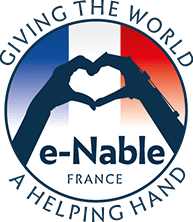The encounter
In 2011, Ian Owen, Jen’s husband, created a mechanical hand for a Steampunk convention. After that, he and his wife posted a video of the device on Youtube.
This video would change their lives and the lives of thousands of others forever.
This video indeed led a carpenter named Richard, living in South Africa and who had lost his fingers in a mechanical accident, to write to them and to trigger a collaboration 16,000 km away, which lasted almost a year, to create a replacement finger for him. They worked on different prototypes using Skype and email, using items easy to find in both countries.
Which ultimately led the mom of a five-year-old boy named Liam who was born fingerless in his right hand to contact them to find out if it would be possible to build a scaled-down version of this device for him.
After creating the first prototype for Liam, Ian realized that the little boy would quickly grow up and have to change regularly. He began to think about using 3D printing to create the next version. He learned to use modeling software, and with two printers donated by a 3D printing company he was able to work on a stronger and more functional model.
Together they created the first 3D printed mechanical hand
Instead of patenting and profiting from the design of this new hand, Jen and Ian Owen decided to put the files in the public domain, open source, so that not only Liam could have a hand, but also that anyone can download and print these devices for anyone who needs them, anywhere in the world.
In January 2013 the files were uploaded to Thingiverse in their rudimentary initial design. With Ian and Jen Owen’s hope that other, more skilled modelers will take the remais, improve the design, and republish it in turn. And that is precisely what happened.
In July 2013 Jon Schull, Professor at RIT (Rochester Institute of Technology), discovered the video of Liam and his 3D hand and found that people were leaving comments and offering to share their 3D printer to make hands for people. needing it.
He created a Google+ group and a map allowing makers to share their geographic position, to allow recipients to find the closest volunteer. He added a comment to the video inviting volunteers to sign up.
The e-Nable community started with around 100 people simply offering to print existing files, and a handful of devices were built as a result. And then something great happened. 3D designers and modelers signed up and started doing exactly what Ian and Jen hoped to do: improve and re-share models. It was amazing!
The virtuous circle was launched
In that first year (2013-2014), the e-Nable community grew from around 100 members to just over 3,000. Over 750 devices were built around the world.
Over the next year (2014-2015) membership more than doubled to over 7,000, and around 2,000 devices were created and donated in over 45 countries.
All these 3D printed hands and arms were given for free to the recipients by the volunteers of the association, they are thanked.
e-Nable France is an independent 1901 law association that works closely with the e-Nable U.S. movement, it was created to ensure French-speaking coordination and to transmit the spirit and knowledge of e-Nable U.S ..
Thanks to Jen and Ian Owen for initiating this incredible adventure!
Thanks to Jon Schull, Melina Brown and the entire U.S. team for catalyzing goodwill around this extraordinary idea!
Our dearest wish is, with you, to carry this torch in France and in Europe, to continue and amplify this beautiful action.
